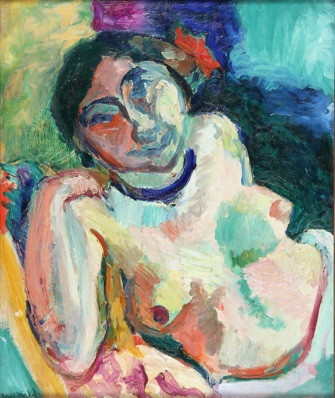
The last thing you would expect to find in Saint Tropez, best known for its bling, is a museum. And not just any museum, but the Musée de L’Annonciade, housed in a charming little deconsecrated 16th-century chapel right next to the port. It is currently holding an exhibition entitled “Le Plus Beau des Petits Musées de France” (“The Most Beautiful Small Museum in France”).
The show celebrates two events that occurred some 60 years ago and changed the nature of the once-sleepy fishing port. Most importantly for the town’s flashy future, in 1956 Brigitte Bardot and her then-husband Roger Vadim arrived with their crew to shoot Et Dieu… Créa la Femme (And God Created Woman). The film created Bardot’s image as the ultimate sex kitten, and it wasn’t long before the yachts of the rich and famous followed. The museum is holding a small side exhibition, “Et Dieu… Créa un Autre Saint Tropez,” with photos and film of what the town looked like in the 1950s. It is also holding screenings in its garden on Monday evenings in July and August of films shot at the time, including Hitchcock’s To Catch a Thief, starring Cary Grant and Grace Kelly, another actress closely identified with the Côte d’Azur.
More importantly, the museum is commemorating the town’s rich artistic past. French artists “discovered” Saint Tropez long before the yacht-setters, led by the Pointillist painter Paul Signac, who first arrived in 1892 and stayed for 20 years. His praise of the beauty of this stretch of the Côte d’Azur helped attract other artists, among them Henri-Edmond Cross, Maximilien Luce, Henri Matisse, Albert Marquet, Charles Camoin and Louis Valtat.
A few of them, notably Henri Person, had the bright idea of creating a museum for their work. Called the Musée Tropelen, it was housed in a room in the Town Hall. This small collection of then-avant-garde works, most of them depicting local scenes, might have been dispersed after the death of Person had it not been for the art collector Georges Grammont, heir to a 19th-century industrial fortune, who moved the museum into L’Annonciade in 1937 and in 1955 donated part of his personal collection to it.
To celebrate the 60th anniversary of that event, the current show features the gems of the collection – which, in addition to the artists mentioned above, also includes works by Pierre Bonnard, Maurice de Vlaminck, Félix Vallotton, Edouard Vuillard and Kees Van Dongen.

On the ground floor of the chapel is an impressive array of colorful, light-filled pictures by some of the best-known artists of the Pointillist, Nabi and Fauve movements. You can almost feel the sea breeze as a sailboat speeds along the gulf under a stormy sky in Signac’s “Saint-Tropez, L’Orage“ (1895; pictured above). André Derain contributes an intensely colored, almost abstract view of water and light in London in “Effets de Soleil sur l’Eau, Londres” (1906), and Georges Braque is represented by one of his pre-Cubist works, “Paysage de l’Estaque” (1906).

Upstairs, notable works include Matisse’s “La Gitane” (1905-06), a portrait of a nude woman that once hung in Grammont’s dining room. Its Fauve colors were so shocking that after dining at Grammont’s house, his sister-in law said she never again wanted to eat a meal while looking at it. Facing it on the opposite wall is a softer depiction of the same model, “La Gitane à l’Atelier” (1906) by Henri Manguin, who had a studio in Paris and shared models with his impecunious painter friends.

If you go to Saint Tropez to see this charming show, I recommend you avoid the high season (July-August) and imperatively have a meal at Club 55 on the beach in Ramatuelle. Not much more than a shack in 1955, as seen in the photos in the Annonciade, it is now a huge restaurant with a shady terrace that serves simple dishes made with top-quality ingredients. I loved the hard-boiled eggs with anchovy mayonnaise, the flavorful tomato salad with a perfect vinaigrette and fresh goat cheese, the barbecued sea bream with crispy fried potatoes, and the dessert of luscious raspberries and strawberries accompanying a local specialty, a tarte Tropézienne, a brioche cake filled with two types of cream. During this so-Tropézienne meal, with the sun dappling the tables, I half expected to see the young Bardot to come slinking and pouting her way through the restaurant…
Musée de l’Annonciade: Place Grammont, 83990 Saint Tropez. Tel.: 04 94 17 84 10. Open 10am-1pm and 2pm-6pm. Closed Tuesday. Admission: €6. Exhibition through October 19. www.saint-tropez.fr
Club 55: 43, boulevard Patch, 83350 Ramatuelle. Tel.: 04 94 55 55 55. www.club55.fr
Favorite
